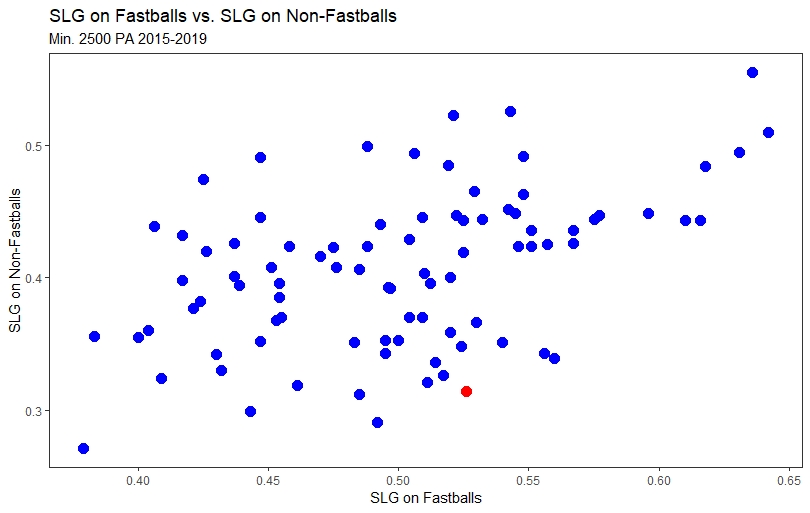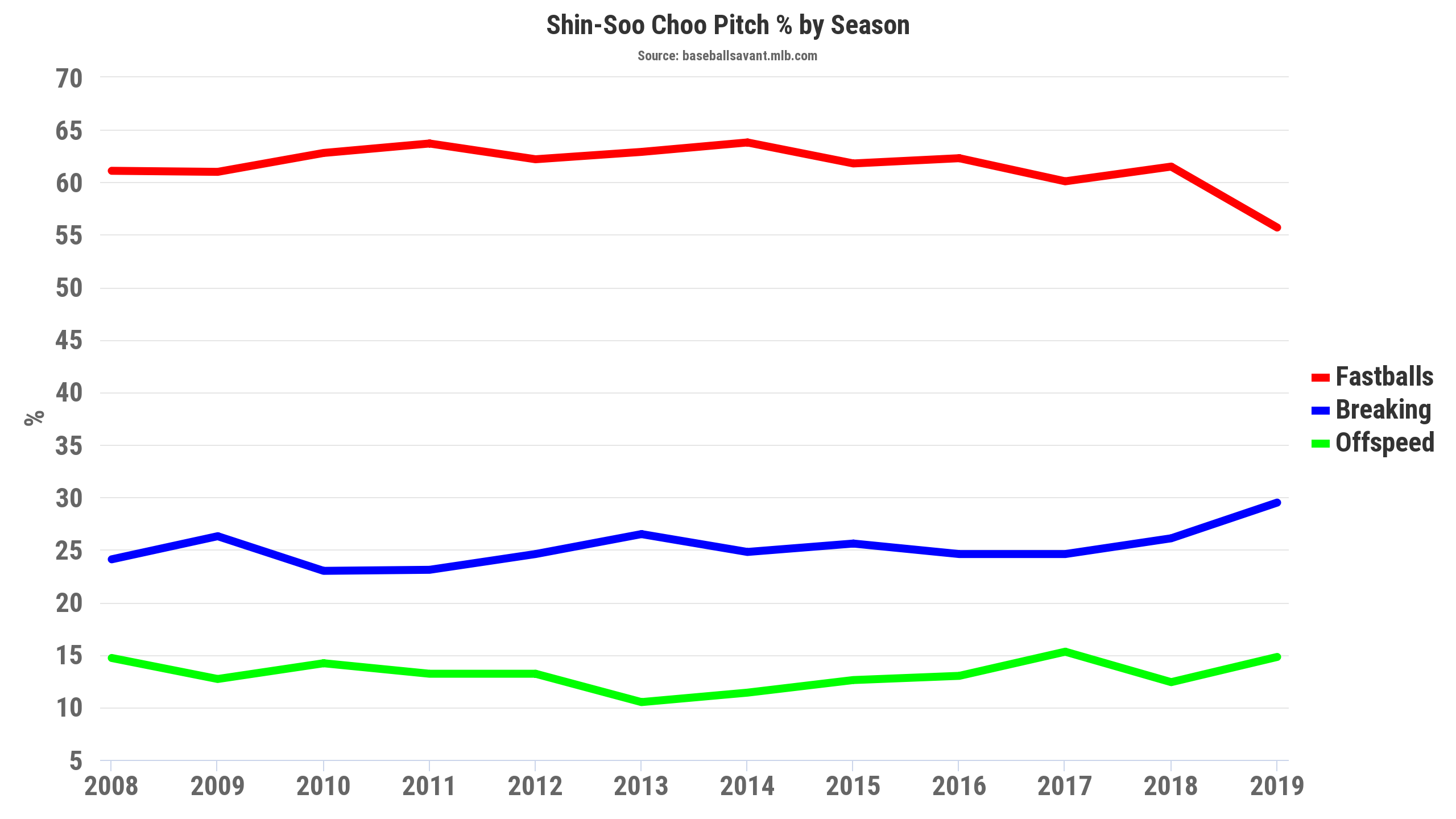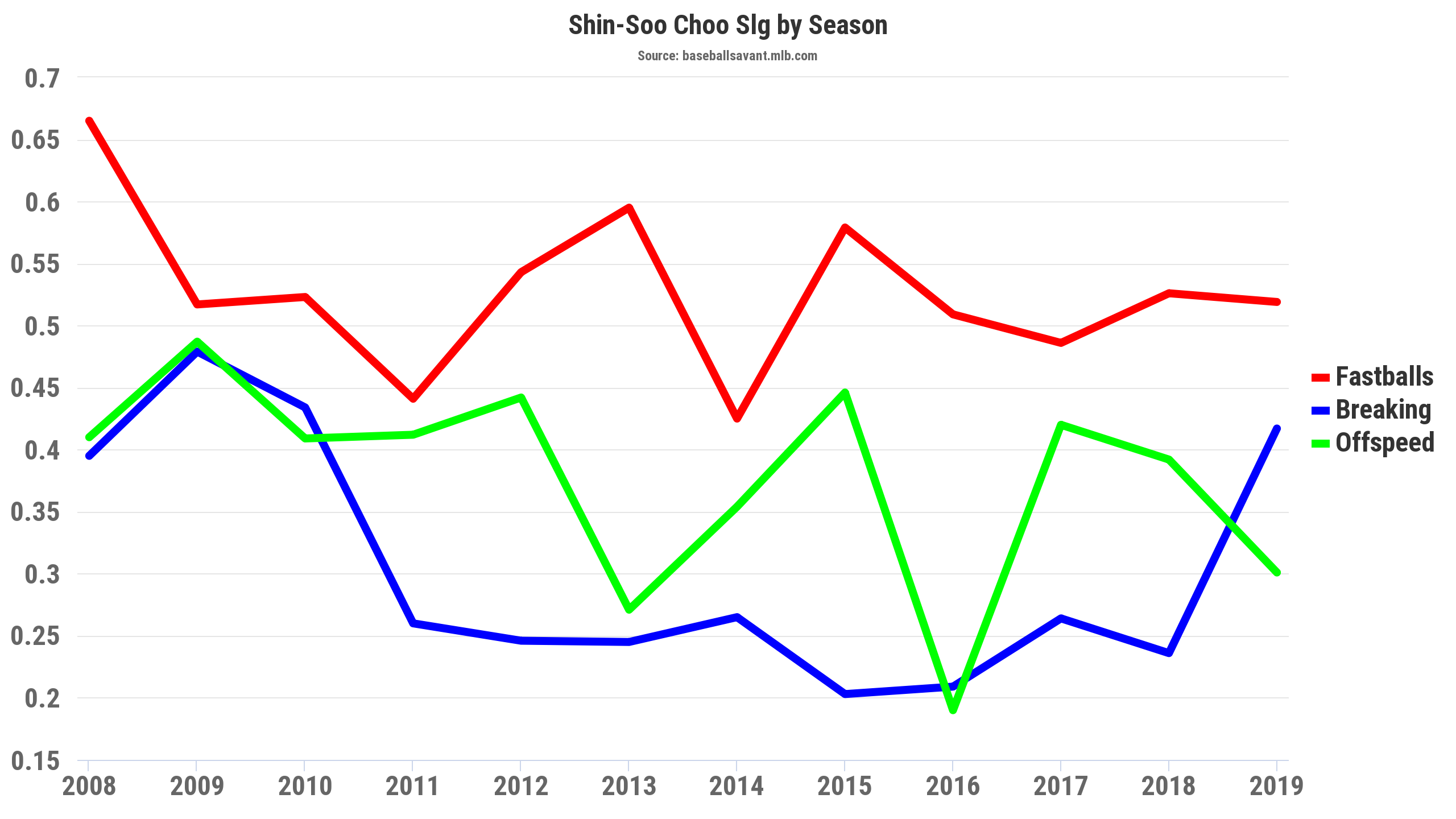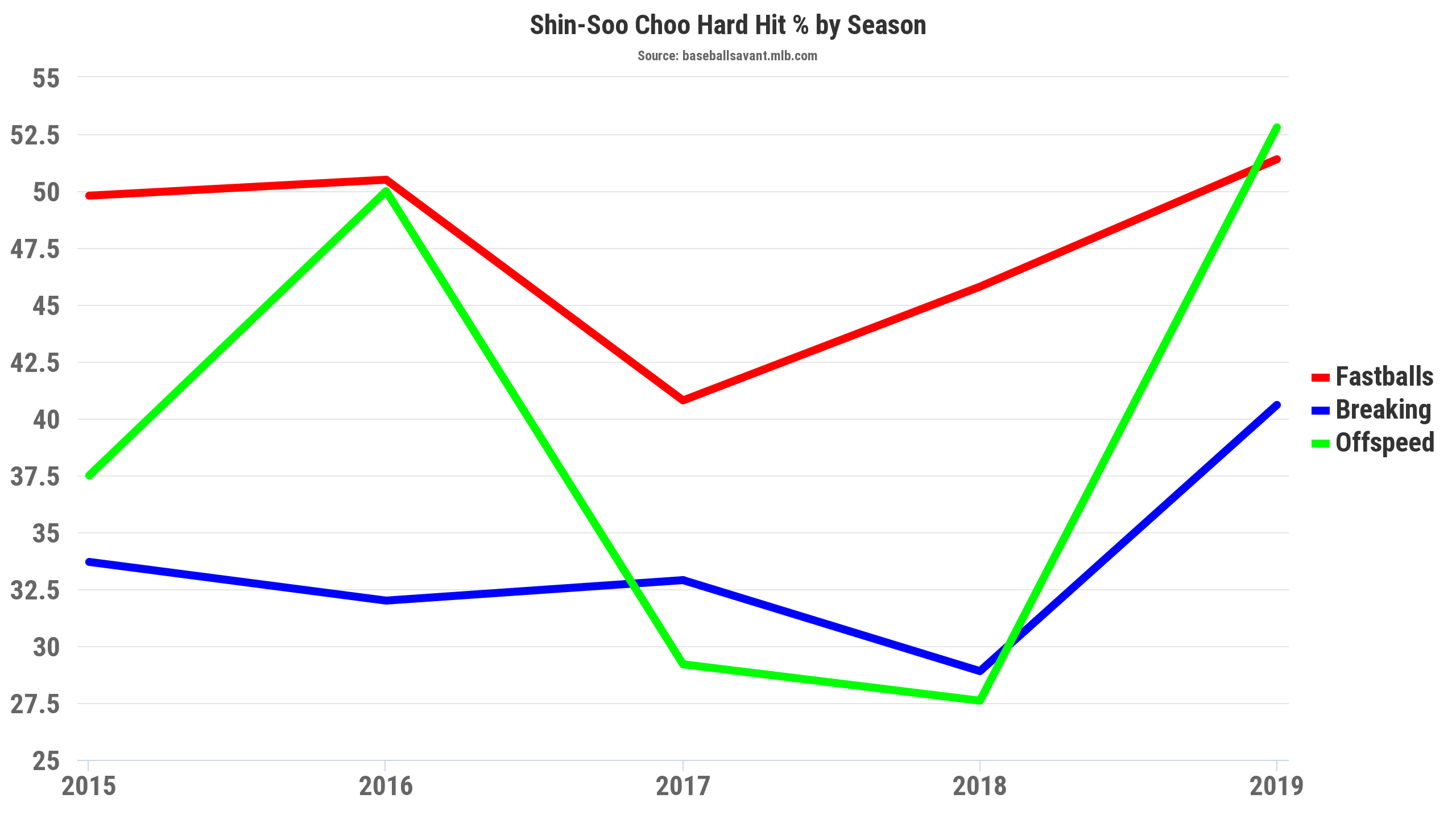While teams probably wouldn’t sign a player entering his age 31 season to a premium-priced seven-year $130 million contract in free agency that the Texas Rangers signed Shin-Soo Choo to before the 2014 season, Choo has, for the most part, continued to be a solid, reliable hitter for the majority of the contract. However, factors such as declining defense haven’t made him as valuable in terms of WAR as he once was, so the contract is likely to be viewed as one that ultimately didn’t give the team the best return. While it’s true that Choo has provided the Rangers just 8.4 bWAR and 8.9 fWAR through the first six seasons of the deal, it is also true that Choo’s bat has mostly held up and has even gotten better as more time passes along.
Choo will soon turn 38-years-old and 2020 was supposed to be the final season of his Rangers contract. While the Rangers perhaps weren’t yet poised to be a top team in the American League this season, Choo was still going to be an important part of their season if they were going to compete. Choo has a history of mentoring young players and could help out in that way during what could be his final season with the team. He also played the mentor role in a big way even without games being played by donating $1,000 to every Rangers minor leaguer, a gesture that shows how much he cares about paying things forward to a new generation of players. With a 2020 season still very much in jeopardy and this being the final year of his mega-deal, it’s certainly possible that 2020 could be his final season after this is all said and done.
That being said, Choo is a hitter that doesn’t appear to be slowing down with age. Choo has a good foundation as a hitter with very good plate discipline, which should give him a profile that ages better than others. In 2019, Choo raised his game even more compared to his prior five seasons with the Rangers:
| Season | G | AVG | OBP | SLG | HR | RBI | R | SB |
|---|---|---|---|---|---|---|---|---|
| 2014 | 123 | 0.242 | 0.340 | 0.374 | 13 | 40 | 58 | 3 |
| 2015 | 149 | 0.276 | 0.375 | 0.463 | 22 | 82 | 94 | 4 |
| 2016 | 48 | 0.242 | 0.357 | 0.399 | 7 | 17 | 27 | 6 |
| 2017 | 149 | 0.261 | 0.357 | 0.423 | 22 | 78 | 96 | 12 |
| 2018 | 146 | 0.264 | 0.377 | 0.434 | 21 | 62 | 83 | 6 |
| 2019 | 151 | 0.265 | 0.371 | 0.455 | 24 | 61 | 93 | 15 |
Outside of a disastrous first season and an injury-shortened 2016, Choo could pretty much be penciled in for a .260 average, around 20 homers, close to 90 runs, and a good helping of RBIs, although opportunities are more limited with him usually hitting leadoff for the Rangers. As noted here, Choo has quietly been a top-20 most profitable player over the past five seasons according to the Razzball player rater. It might seem shocking, but Choo’s boring, yet solid production makes him an overall productive hitter for fantasy purposes. Despite being consistently solid for years now, Choo still remains extremely cheap in drafts, with an ADP of 231 in the NFBC, and as low as 301 in Yahoo leagues. It’s understandable why, as he is not getting any younger and doesn’t have a sexy profile as a hitter by any means. History shows that Choo will return exceptional value, but he continues to be overlooked. While it’s possible 2019 could have been the last season where that is the case, his 2019 season was even more improved as the power returned. He set a new career-high in home runs, while also chipping in 15 steals. Sure, there were a lot of hitters that set new career highs in home runs in such an extreme offensive environment, but Choo also took some steps forward at the plate in 2019 that helped drive his strong numbers and showed that his jump in slugging wasn’t just due to the environment, but rather him getting better, and at an age where players aren’t usually expected to get better. Choo really has gotten better with age, so let’s take a look at how that happened.
While the biggest part of Choo’s profile as a hitter has always been his strong plate discipline with walk rates usually around 11%, in terms of batted-balls, Choo has always done the majority of his damage on fastballs. Going back to 2015, we can see how good he’s been at hitting fastballs:
| Season | SLG | xSLG |
|---|---|---|
| 2015 | 0.579 | 0.553 |
| 2016 | 0.509 | 0.534 |
| 2017 | 0.486 | 0.538 |
| 2018 | 0.526 | 0.570 |
| 2019 | 0.519 | 0.519 |
Going back to 2015, we see that Choo has consistently been a good fastball hitter and this isn’t just something that has popped up over the past five seasons. Choo has always been a good fastball hitter since getting his first real consistent playing time way back in 2008. Looking at his slugging marks on fastballs from 2008-2014 that are not included in the table, Choo’s average slugging is .530. For additional context, since 2015, Choo’s .526 slugging on fastballs is the 27th-highest among all hitters with at least 2500 plate appearances in that span, a group of 88 hitters. His .550 xSLG is even better and moves him up to 19th among hitters in the same group.
How about his results on non-fastballs in the same span? Well, they aren’t great. He’s slugged just .314 on non-fastballs since 2015, which ranks him 84th out of the same 88 hitters. His .349 xSLG is a little bit better, but it’s still 70th out 88 hitters. That’s a .212 point difference between slugging on fastballs and non-fastballs, which is the third-highest discrepancy among the 88 hitters in this group, and visualized in red on the graph below:

That big difference creates quite a conundrum. Let’s isolate 2018 for a moment because that’s when things were even worse for Choo when it comes to his non-fastball results. Choo had a slugging mark of just .289 on non-fastballs, which ranked him 133rd out of 144 hitters with at least 500 plate appearances. Choo was still excellent at hitting fastballs though, as shown in the earlier table, with his .526 slugging on fastballs representing the 37th best mark out of the same 144 hitters, and his .570 xSLG placing him 21st. This time though, the difference between Choo’s slugging on non-fastballs compared to fastballs was even larger than his overall difference from 2015 to 2019 of .212. In 2018, Choo’s .237 point difference in slugging of these pitch types was the eighth largest difference, again among the same 144 hitters with at least 500 plate appearances. This creates a conundrum because, in case you weren’t aware, pitchers are throwing fewer and fewer fastballs these days, and it makes more sense than ever to stop throwing fastballs to such a good fastball hitter, especially to one who struggles with non-fastballs, such as a hitter like Choo.
That’s exactly what pitchers did to Choo in 2019:

Through eleven years’ worth of data, we can see that Choo generally has seen a little more than 60% fastballs prior to 2019. In 2019 though, Choo saw fewer fastballs than he ever had previously, with the rate dropping all the way down to 55.7%. Instead, he saw over four percent more breaking balls, to also go along with more offspeed pitches. If Choo could’ve changed his results on non-fastballs, then his 2019 would have looked a lot different and we could be talking about Choo simply being another player with a big contract that couldn’t last through the duration of the deal.
With Choo already being at an advanced age heading into 2019, it wouldn’t be expected for him to suddenly learn some new tricks and start hitting non-fastballs with more authority. He didn’t even exactly do that; instead, he was simply better than he had ever been on non-fastballs, specifically breaking pitches, which were the pitch type that gave him the most headaches previously in his career:

You have to go all the way back to 2010 to find a season where Choo slugged greater than .300 on breaking balls. He did not all of a sudden turn into an expert at hitting breaking balls, as his .417 slugging mark on the pitch was just 73rd out of 137 hitters with at least 500 plate appearances in 2019, but simply going from one of the worst, to simply average in this department made enough of a difference to offset the fewer amount of fastballs that he was seeing. And oh yeah, he also was still pretty good at hitting fastballs too and continuing to keep up his reputation as a good fastball hitter.
The most notable improvement in Choo’s 2019 season, however, are the improvements he made in the hard-hit department. While Choo has never really had an issue hitting the ball hard, he never did so at a rate as high as the rate in which he hit them in 2019. His hard-hit rate in 2019 of 49.0% was good enough for 13th among all hitters with at least 300 plate appearances, sandwiching him right between Christian Yelich and Yordan Alvarez on the leaderboard, which is surely some good company to keep. Of course, part of this comes back to his results on non-fastballs since he really started hitting those pitch types harder than ever:

We see from this that not only did Choo’s hard-hit rate on non-fastballs jump, he actually hit more offspeed pitches harder than he did his fastballs. If you’re interested in seeing some mechanical tweaks that Choo made in 2019 that perhaps drove these results, you can read about it here and here as it does appear that Choo changed up some things pre-pitch that have made a significant difference in this department.
Ultimately, what stands out the most when drilling Choo’s hard-hit rate is that he was able to accomplish all of this while still being primarily a groundball hitter. There wasn’t any of the launch angle revolution going on with Choo, as he still was hitting 50.6% of his batted balls on the ground. Instead, Choo simply took greater advantage of his non-groundballs. To show this, I calculated the hard-hit rates by batted-ball type for every hitter with at least 300 plate appearances in 2019. Choo doesn’t just stand out in terms of overall hard-hit rate, but also when hard-hit rate is broken out by batted-ball type:
| Hard-Hit % | Hard-Hit FB% | Hard-Hit LD% | |
|---|---|---|---|
| Rate | 49.0% | 62.9% | 70.2% |
| Rank (out of 273) | 13 | 12 | 7 |
Despite hitting over 50% groundballs, Choo was able to work around that by hitting so many of the better batted-ball types consistently hard and at one of the best rates in all of baseball. Combine that with such a limited amount of pop-ups at just 3.5%, and all of a sudden this looks like a pretty good batted-ball profile, despite all of the groundballs.
All in all, despite finishing the 2019 season at the ripe age of 37, Choo quietly underwent a transformation at the plate. Still remaining was his good foundation of a good eye and excellent fastball hitting ability, but he added an improvement to what was historically the weakest area of his game. After being one of the worst hitters in terms of results on non-fastballs, Choo was able to improve substantially to help counter experiencing a difference in pitch mix. Combine that with improvements in hard-hit rate that saw him become one of the league’s best hitters in the metric, and we see how Choo was been able to get better at an age where players usually experience the opposite.
It hasn’t always been a pretty tenure for Choo with the Rangers, but as he enters the final seasons of his career, Choo continues to provide positive outcomes at the plate, as well as being a positive influence off the field. He’s done what has been difficult to do for so many hitters by defying the aging curve and has shown no signs of slowing down even as he gets older. With all of this in mind, Choo should continue to remain a boring, unspectacular, but ultimately solid contributor in the future, with a slash line and counting stats that shouldn’t be so far off from where they were in 2019.
Photo by Leslie Plaza Johnson/Icon Sportswire | Adapted by Justin Paradis (@freshmeatcomm on Twitter)

